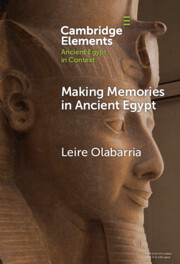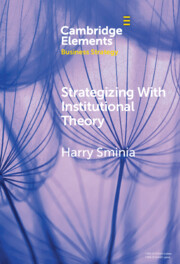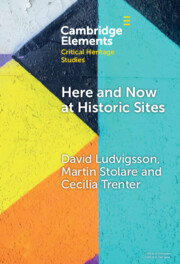82 results
Bonds and affinities among successional spaces: spatial performativity in the New Museum of the Acropolis in Athens
-
- Journal:
- Byzantine and Modern Greek Studies / Volume 49 / Issue 1 / April 2025
- Published online by Cambridge University Press:
- 27 March 2025, pp. 98-111
- Print publication:
- April 2025
-
- Article
- Export citation

Making Memories in Ancient Egypt
-
- Published online:
- 24 March 2025
- Print publication:
- 17 April 2025
-
- Element
- Export citation
Enacting efficient markets: The performativity of quantitative easing
-
- Journal:
- Finance and Society / Volume 11 / Issue 1 / April 2025
- Published online by Cambridge University Press:
- 30 January 2025, pp. 1-20
-
- Article
-
- You have access
- Open access
- HTML
- Export citation
4 - The Role of Gender
-
- Book:
- The Power of Brand Ownership
- Published online:
- 14 January 2025
- Print publication:
- 23 January 2025, pp 63-79
-
- Chapter
- Export citation
Chapter 20 - The Camera Is an Engine: Ways of Seeing Perspective, Context and Reflexivity to Make and Shape Markets through Innovative Research Practice
- from Part V - The Secret Life of Market Studies Methods
-
-
- Book:
- Market Studies
- Published online:
- 22 November 2024
- Print publication:
- 21 November 2024, pp 332-349
-
- Chapter
- Export citation
Chapter 19 - Method Contestations in Marketography: From ‘Fly on the Wall’ to Methods ‘on the Fly’
- from Part V - The Secret Life of Market Studies Methods
-
-
- Book:
- Market Studies
- Published online:
- 22 November 2024
- Print publication:
- 21 November 2024, pp 319-331
-
- Chapter
- Export citation
Chapter 8 - Nudging as a Tool of Market Design and Profitability: Performativity in the Age of Behavioural Economics
- from Part II - Post-Performative Approaches to Studying Markets
-
-
- Book:
- Market Studies
- Published online:
- 22 November 2024
- Print publication:
- 21 November 2024, pp 127-143
-
- Chapter
- Export citation
Chapter 9 - The Social Life of Simulated Markets: A Market Studies Approach
- from Part II - Post-Performative Approaches to Studying Markets
-
-
- Book:
- Market Studies
- Published online:
- 22 November 2024
- Print publication:
- 21 November 2024, pp 144-160
-
- Chapter
- Export citation
Chapter 6 - The Performativity Test
- from Part II - Post-Performative Approaches to Studying Markets
-
-
- Book:
- Market Studies
- Published online:
- 22 November 2024
- Print publication:
- 21 November 2024, pp 100-113
-
- Chapter
- Export citation
Chapter 24 - What about Gender? An Invitation to Market Studies Scholars
- from Part VI - Broadening the Perspectives in Market Studies
-
-
- Book:
- Market Studies
- Published online:
- 22 November 2024
- Print publication:
- 21 November 2024, pp 405-415
-
- Chapter
- Export citation
Chapter 23 - Digital Texts as Market Actors: A Semantic Network Analysis
- from Part V - The Secret Life of Market Studies Methods
-
-
- Book:
- Market Studies
- Published online:
- 22 November 2024
- Print publication:
- 21 November 2024, pp 382-400
-
- Chapter
- Export citation
Chapter 7 - Performative Struggles and Theory–Practice Decoupling in the Design and the Implementation of a Market-Based Instrument: French Tradable Certificates for Energy Efficiency
- from Part II - Post-Performative Approaches to Studying Markets
-
-
- Book:
- Market Studies
- Published online:
- 22 November 2024
- Print publication:
- 21 November 2024, pp 114-126
-
- Chapter
- Export citation
“Watch Your Tone!”: Music and Meaning in Bobi Wine’s “Tugambire ku Jennifer” and the Kampala Street Vendors
-
- Journal:
- African Studies Review / Volume 67 / Issue 4 / December 2024
- Published online by Cambridge University Press:
- 14 November 2024, pp. 920-940
-
- Article
-
- You have access
- Open access
- HTML
- Export citation
Changing Nationalist Styles in Galicia: The Politics of Dual Identity
-
- Journal:
- Nationalities Papers , FirstView
- Published online by Cambridge University Press:
- 04 November 2024, pp. 1-24
-
- Article
-
- You have access
- Open access
- HTML
- Export citation
Paper Steaks: Live Cattle Futures Markets and the Financial Revolution of 1964
-
- Journal:
- Enterprise & Society , First View
- Published online by Cambridge University Press:
- 31 May 2024, pp. 1-32
-
- Article
-
- You have access
- Open access
- HTML
- Export citation

Strategizing With Institutional Theory
-
- Published online:
- 21 May 2024
- Print publication:
- 13 June 2024
-
- Element
- Export citation

Here and Now at Historic Sites
- Pupils and Guides Experiencing Heritage
-
- Published online:
- 02 May 2024
- Print publication:
- 23 May 2024
-
- Element
-
- You have access
- Open access
- HTML
- Export citation
Introduction
-
- Book:
- Before the Word Was Queer
- Published online:
- 14 March 2024
- Print publication:
- 21 March 2024, pp 1-29
-
- Chapter
- Export citation
Chapter 10 - Nietzsche and Wagner: The Logic of Contradiction
- from II - People
-
-
- Book:
- Wagner in Context
- Published online:
- 14 March 2024
- Print publication:
- 14 March 2024, pp 104-112
-
- Chapter
- Export citation
5 - Consenting to International Law in Five Moves
- from Part I - Notions and Roles of Consent
-
-
- Book:
- Consenting to International Law
- Published online:
- 23 November 2023
- Print publication:
- 07 December 2023, pp 117-134
-
- Chapter
- Export citation


